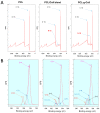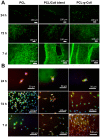Biosynthetic PCL-graft-Collagen Bulk Material for Tissue Engineering Applications
- PMID: 28773053
- PMCID: PMC5551736
- DOI: 10.3390/ma10070693
Biosynthetic PCL-graft-Collagen Bulk Material for Tissue Engineering Applications
Abstract
Biosynthetic materials have emerged as one of the most exciting and productive fields in polymer chemistry due to their widespread adoption and potential applications in tissue engineering (TE) research. In this work, we report the synthesis of a poly(ε-caprolactone)-graft-collagen (PCL-g-Coll) copolymer. We combine its good mechanical and biodegradable PCL properties with the great biological properties of type I collagen as a functional material for TE. PCL, previously dissolved in dimethylformamide/dichloromethane mixture, and reacted with collagen using carbodiimide coupling chemistry. The synthesised material was characterised physically, chemically and biologically, using pure PCL and PCL/Coll blend samples as control. Infrared spectroscopy evidenced the presence of amide I and II peaks for the conjugated material. Similarly, XPS evidenced the presence of C-N and N-C=O bonds (8.96 ± 2.02% and 8.52 ± 0.63%; respectively) for PCL-g-Coll. Static contact angles showed a slight decrease in the conjugated sample. However, good biocompatibility and metabolic activity was obtained on PCL-g-Coll films compared to PCL and blend controls. After 3 days of culture, fibroblasts exhibited a spindle-like morphology, spreading homogeneously along the PCL-g-Coll film surface. We have engineered a functional biosynthetic polymer that can be processed by electrospinning.
Keywords: biosynthetic; collagen; conjugation; electrospinning; poly(ε-caprolactone); tissue engineering.
Conflict of interest statement
The authors declare no conflict of interest.
Figures









Similar articles
-
Structural and Surface Compatibility Study of Modified Electrospun Poly(ε-caprolactone) (PCL) Composites for Skin Tissue Engineering.AAPS PharmSciTech. 2017 Jan 1;18(1):72-81. doi: 10.1208/s12249-016-0500-8. Epub 2016 Feb 16. AAPS PharmSciTech. 2017. PMID: 26883261
-
Guidance of glial cell migration and axonal growth on electrospun nanofibers of poly-epsilon-caprolactone and a collagen/poly-epsilon-caprolactone blend.Biomaterials. 2007 Jul;28(19):3012-25. doi: 10.1016/j.biomaterials.2007.03.009. Epub 2007 Mar 19. Biomaterials. 2007. PMID: 17408736
-
Surface modification of ultra thin poly (epsilon-caprolactone) films using acrylic acid and collagen.Biomaterials. 2004 May;25(11):1991-2001. doi: 10.1016/j.biomaterials.2003.08.038. Biomaterials. 2004. PMID: 14741613
-
A two-step method using air plasma and carbodiimide crosslinking to enhance the biocompatibility of polycaprolactone.J Biomed Mater Res B Appl Biomater. 2017 Aug;105(6):1658-1666. doi: 10.1002/jbm.b.33708. Epub 2016 May 14. J Biomed Mater Res B Appl Biomater. 2017. PMID: 27177842
-
In vivobiocompatibility and biodegradability of poly(lactic acid)/poly(ε-caprolactone) blend compatibilized with poly(ε-caprolactone-b-tetrahydrofuran) in Wistar rats.Biomed Phys Eng Express. 2021 Mar 15;7(3). doi: 10.1088/2057-1976/abeb5a. Biomed Phys Eng Express. 2021. PMID: 33652429
Cited by
-
PCL-Based Composite Scaffold Matrices for Tissue Engineering Applications.Mol Biotechnol. 2018 Jul;60(7):506-532. doi: 10.1007/s12033-018-0084-5. Mol Biotechnol. 2018. PMID: 29761314 Review.
-
Applications of 3D Bioprinted-Induced Pluripotent Stem Cells in Healthcare.Int J Bioprint. 2020 Jul 30;6(4):280. doi: 10.18063/ijb.v6i4.280. eCollection 2020. Int J Bioprint. 2020. PMID: 33088994 Free PMC article. Review.
-
Polymer- and Hybrid-Based Biomaterials for Interstitial, Connective, Vascular, Nerve, Visceral and Musculoskeletal Tissue Engineering.Polymers (Basel). 2020 Mar 9;12(3):620. doi: 10.3390/polym12030620. Polymers (Basel). 2020. PMID: 32182751 Free PMC article. Review.
-
Poly (ε-caprolactone)-based electrospun nano-featured substrate for tissue engineering applications: a review.Prog Biomater. 2021 Jun;10(2):91-117. doi: 10.1007/s40204-021-00157-4. Epub 2021 Jun 2. Prog Biomater. 2021. PMID: 34075571 Free PMC article. Review.
-
Evaluation of Polycaprolactone Electrospun Nanofiber-Composites for Artificial Skin Based on Dermal Fibroblast Culture.Bioengineering (Basel). 2022 Jan 6;9(1):19. doi: 10.3390/bioengineering9010019. Bioengineering (Basel). 2022. PMID: 35049727 Free PMC article.
References
-
- Dhandayuthapani B., Yoshida Y., Maekawa T., Sakthi Kumar D. Polymeric scaffolds in tissue engineering application: A review. Int. J. Polym. Sci. 2011;2011:290602. doi: 10.1155/2011/290602. - DOI
-
- Sefat F., McKean R., Deshpande P., Ramachandran C., Hill C.J., Sangwan V.S., Ryan A.J., MacNeil S. Production, sterilisation and storage of biodegradable electrospun PLGA membranes for delivery of limbal stem cells to the cornea. Procedia Eng. 2013;59:101–116. doi: 10.1016/j.proeng.2013.05.099. - DOI
-
- Deshpande P., Ramachandran C., Sefat F., Mariappan I., Johnson C., McKean R., Hannah M., Sangwan V.S., Claeyssens F., Ryan A.J. Simplifying corneal surface regeneration using a biodegradable synthetic membrane and limbal tissue explants. Biomaterials. 2013;34:5088–5106. doi: 10.1016/j.biomaterials.2013.03.064. - DOI - PubMed
LinkOut - more resources
Full Text Sources
Other Literature Sources

